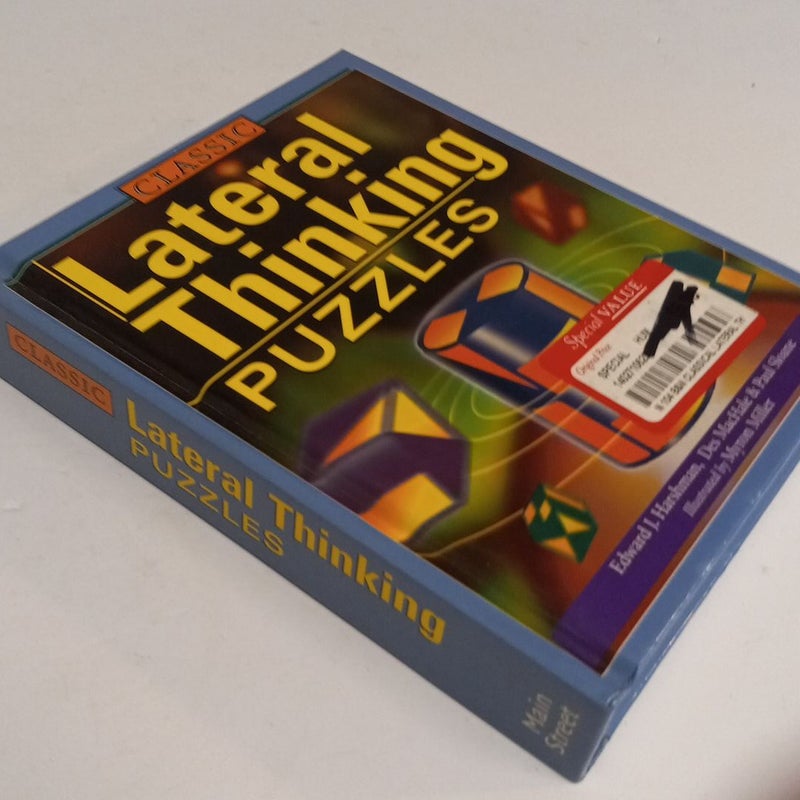Introduction to Lateral Thinking Puzzles
Lateral thinking puzzles stand out as unique brain teasers. They invite solvers to think outside the box. Unlike traditional puzzles that rely on logic and step-by-step reasoning, lateral thinking puzzles demand a creative and non-linear approach. These puzzles often present a scenario that seems illogical or impossible at first. But, they have solutions that are simple, yet surprising, once you shift your perspective.
To solve lateral thinking puzzles, you need to discard preconceptions. Look for new ways of interpreting information. It’s about breaking free from conventional thought patterns. One popular example is the puzzle of how to save a drowning man without getting wet. These types of questions force you to consider unusual solutions. For instance, maybe the answer lies in manipulating the environment around the man, rather than entering the water.
Engaging with lateral thinking puzzles can sharpen your mind. It enhances your problem-solving skills in everyday situations. They are not just mental exercises, they are tools that can train your brain to identify and exploit hidden opportunities in real-world problems. So, let’s embark on a journey of curiosity and creativity. Let’s explore the art of lateral thinking puzzles and the benefits they yield.
The Benefits of Lateral Thinking Exercises
Lateral thinking exercises offer a wealth of advantages for both mind and cognition. Engaging in these puzzles enhances creative thought and fosters innovative problem-solving skills. When you practice thinking laterally, you learn to see beyond the surface. You discover hidden connections and alternative solutions. The benefits of lateral thinking exercises include:
- Improved Creativity: These exercises push you to think differently and generate unique ideas.
- Enhanced Problem-Solving: They train you to look for non-obvious solutions and to approach problems from new angles.
- Cognitive Flexibility: Lateral thinking expands your ability to alter thought patterns and adapt to new situations.
- Mental Agility: Regular practice can sharpen mental reflexes and boost your ability to process information quickly.
- Stress Relief: The playful nature of lateral thinking puzzles can reduce stress and provide a fun break from routine tasks.
- Increased Curiosity: They encourage asking questions and exploring the ‘why’ and ‘how’ of different scenarios.
- Team-Building: In group settings, these puzzles promote cooperation and communication among participants.
- Preparation for the Unexpected: By embracing unforeseen solutions, you’ll be better equipped to handle real-life surprises.
Incorporating lateral thinking exercises into your daily routine could be transformative. They don’t just amuse; they build mental resilience and empower you to face challenges head-on. For those wishing to sharpen their wits and expand their intellectual horizons, lateral thinking puzzles are an excellent resource.
Classic Examples of Lateral Thinking Puzzles
When exploring the realm of lateral thinking puzzles, the joy lies in the ‘aha!’ moment. Here are some classic examples that showcase the ingenuity of lateral thinking.
- The Scissors Puzzle: Here, the challenge is to figure out how a pair of scissors can cut a hole in a sheet of paper to create a square. The answer relies not on cutting a square outline, but rather, on folding the paper creatively before making a single cut.
- The Drowning Man Puzzle: This is the example previously discussed, where you need to save a drowning man without getting wet. The unexpected solution? You can shoot a bullet into the water near him to create a wave that pushes him to shore.
- The Boiling Egg Puzzle: If you need to boil an egg for exactly three minutes, but only have a two-minute sand timer and a four-minute sand timer, how would you do it? The lateral thinking solution involves starting both timers while you begin boiling the egg and using the time intervals wisely.
These examples perfectly illustrate how lateral thinking puzzles push your cognitive boundaries. They compel you to ditch linear reasoning and embrace a creative approach to problem-solving.
Integrating these types of puzzles into your activities can greatly aid cognitive development. They make excellent tools for enhancing creativity, problem-solving, and mental flexibility as discussed earlier. Whether you’re in search of a mental workout or just a fun activity to pass the time, lateral thinking puzzles provide both challenge and amusement.

How to Approach Solving Lateral Thinking Puzzles
When faced with lateral thinking puzzles, the approach is key for breaking through to a solution. As you embark on solving these puzzles, start by setting aside any preconceived notions about how things work. Remember, these aren’t your typical problems — they require out-of-the-box thinking. Here’s a straightforward strategy to guide you through any lateral thinking puzzle you encounter:
- Stay Open-Minded: Initially, accept the scenario as it is presented without judgment.
- Break Down the Problem: Identify the key elements of the puzzle, and consider their relationship to each other.
- Explore Different Perspectives: Try viewing the problem from various angles. Ask yourself, what if the obvious isn’t so?
- Challenge Assumptions: Question everything. Are there assumptions you’re unconsciously making?
- Brainstorm Creative Solutions: Don’t hold back any ideas, no matter how far-fetched they may seem at first.
- Encourage Wild Ideas: The wildest idea could be the key to unlocking the puzzle.
- Use Lateral Moves: If you’re stuck, shift your focus around. Look at the puzzle from a different starting point.
By following these steps, you will develop the flexibility needed to solve lateral thinking puzzles effectively. It’s important to relax and enjoy the process. Stress and frustration can block creative thoughts. Take a deep breath, let your imagination run free, and have fun with the challenge. Over time, you’ll find that your ability to tackle these puzzles improves, leading to faster and more satisfying ‘aha!’ moments.
Tips and Strategies to Master Lateral Thinking Puzzles
Mastering lateral thinking puzzles requires practice and a set of strategies tailored to this unique form of problem-solving. Here are effective tips and approaches to enhance your capacity for lateral thinking:
- Start with a Clear Mind: Enter each puzzle with a blank slate. Let go of expectations and let curiosity lead.
- Follow the ‘Yes, And…’ Technique: Build on each idea. Accept the first thought, then expand on it to explore new possibilities.
- Visualize Scenarios: Picture the puzzle in your mind. Visual aids can often spur ideas that words alone may not.
- Write Down Your Thoughts: Jot down any solutions that cross your mind. Physical notes can help you sort and develop ideas.
- Practice Regularly: Consistent effort strengthens your lateral thinking muscles. Dedicate time to solve these puzzles frequently.
- Take Breaks if Stuck: A fresh perspective often comes after stepping away from the problem for a while.
- Embrace Failure: Don’t fear wrong answers. Every attempt offers valuable lessons and gets you closer to creative breakthroughs.
- Learn from Others: Share puzzles with friends. Collaboration can reveal insights you might have missed.
By applying these strategies, you’re likely to become better at discerning the typically unexpected solutions that lateral thinking puzzles call for. Remember that the journey to mastering these puzzles is as enjoyable as it is fulfilling. Keep challenging yourself and embrace the quirky logic of lateral thinking!
Lateral Thinking Puzzles for Kids vs. Adults
Lateral thinking puzzles are not all created equal. They vary in complexity to suit different age groups. For kids, these puzzles are tailored to be simpler. They encourage creative thinking without overwhelming young minds. Adults, on the other hand, face puzzles with more nuanced scenarios. These require a deeper level of critical thinking and experience to solve.
For Kids:
- Puzzles designed for children often involve more tangible and straightforward problems.
- They use familiar situations or elements, making them relatable and easier to interpret.
- The simplicity helps in teaching the basics of lateral thinking, like looking at problems from multiple perspectives.
For Adults:
- Adult puzzles typically present more abstract challenges that call for intellectual agility.
- They can incorporate elements of real-world complexity, reflecting the intricate nature of adult decision-making.
- These puzzles are meant to stretch the problem-solving abilities and push the limits of creative thought.
Understanding the audience is crucial when choosing the right lateral thinking puzzle. When selecting puzzles for children, focus on fostering their creativity and critical thinking. For adults, choose puzzles that provide a mental workout and encourage innovative approaches to complex problems. Whether for kids or adults, lateral thinking puzzles promote fun and learning through unconventional problem-solving.
Online Resources to Find Lateral Thinking Puzzles
Finding quality lateral thinking puzzles can be a task in itself. With the right online resources, you can discover a vast array of puzzles to challenge your creativity and problem-solving skills. Here are some recommended websites and platforms where you can find an assortment of lateral thinking puzzles:
- Puzzle Websites: Dedicated puzzle sites often have sections for lateral thinking challenges. These may range from beginner to expert levels, ensuring there’s something for everyone.
- Social Media Groups: Join groups on platforms like Facebook or Reddit. Members often share and discuss various lateral thinking puzzles.
- Mobile Apps: There are several apps designed specifically for lateral thinking puzzles. Check your app store for highly-rated puzzle apps.
- Blogs and Forums: Seek out blogs that specialize in brain teasers and puzzles. Users typically post new puzzles and discuss different solutions.
- Educational Sites: Websites that focus on education and learning development may offer lateral thinking puzzles alongside other resources.
When searching for the perfect lateral thinking puzzle online, remember to consider your skill level and the level of challenge you enjoy. With these resources, you’ll have a steady stream of puzzles at your fingertips, ready to provide you with endless mental stimulation and fun.
Common Pitfalls When Solving Lateral Thinking Puzzles
Solving lateral thinking puzzles can sometimes trip people up. Common mistakes might prevent you from reaching that ‘aha!’ moment. Here are some pitfalls to watch out for:
Jumping to Conclusions: Many times, solvers rush to answer before fully exploring the problem. Take your time to think it through.
Overthinking: While these puzzles need creative thinking, overcomplicating your solution can hinder progress. Simplicity is often key.
Sticking to Conventional Logic: Lateral thinking puzzles break the mold of normal reasoning. Don’t get stuck in traditional thought patterns.
Ignoring the Obvious: Sometimes, the answer is straight in front of you. Keep an eye out for simple solutions.
Not Questioning Assumptions: We often accept the first assumption that comes to mind. Challenge your initial thoughts to find new angles.
Getting Frustrated: Letting irritation take over can block your creative flow. Stay calm and keep a positive mindset.
By avoiding these common errors and employing patience and open-mindedness, you can improve your lateral thinking skills. With practice, recognizing and overcoming these pitfalls becomes easier, leading to more success in solving lateral thinking puzzles.


